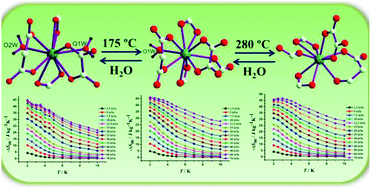Temperature- and vapor-induced reversible single-crystal-to-single-crystal transformations of three 2D/3D GdIII–organic frameworks exhibiting significant magnetocaloric effects†
Abstract
By using Gd2O3, propanedioic acid (H2pda) and oxalic acid (H2ox), a new Gd-based metal–organic framework (MOF) [Gd(pda)(ox)0.5(H2O)2]n (1) has been successfully constructed and structurally characterized. Interestingly, temperature- and vapor-induced reversible single-crystal-to-single-crystal transformations occurred and two new MOFs, namely [Gd(pda)(ox)0.5(H2O)]n (1a) and [Gd(pda)(ox)0.5]n (1b), have been obtained. Complex 1 displays a two-dimensional (2D) layer structure composed of zigzag [Gd(pda)]n chains and it could also be made up of numerous Gd6 macrocycles. Thermal dehydration leads to more complicated three-dimensional (3D) ‘pillar-layer’ structures (1a and 1b) with the same coordination mode of pda2− anions. Magnetic studies suggest the presence of ferromagnetic couplings between the intrachain or intralayer GdIII ions and large magnetocaloric effects (MCEs) with −ΔSmaxm = 45.0 J kg−1 K−1 (1), 46.1 J kg−1 K−1 (1a) and 46.8 J kg−1 K−1 (1b) under a 7 T applied field. Therefore, the interest of ‘robust magnetocaloric MOFs’ is now extended to compounds showing weak ferromagnetic couplings and hence having better magnetocaloric performances for small field changes.



 Please wait while we load your content...
Please wait while we load your content...